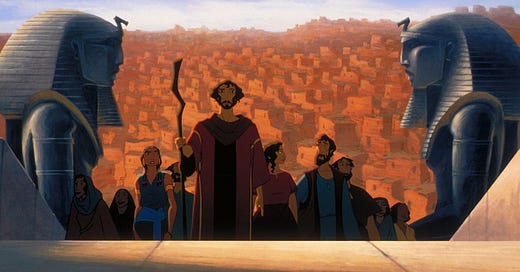The Prince of Egypt movie saved my faith before it needed saving. This animated-but-not-minor movie (Stephen Schwartz and Hans Zimmer wrote the music after all!) harnessed the power of storytelling at a pivotal moment in my spiritual development. Is it even a children’s movie? I hesitate to classify it so narrowly. The story of the Exodus entered my soul through its animated art and music and never left. It was a formative experience of the power of faith conveyed through art, a paradigm I’m continuing to examine this Lenten season.
Back in 1998, sitting captivated in the theater, I felt that I was beholding the power and beauty of God. I had gone to see the movie with my neighbors, and I remember my friend turning to me afterwards and saying, “I just love God!”
“Me too!” I sighed.
After we got home, I grabbed my Bible and took it straight to the couch, tearing into the story of Exodus. The story was there! This really was the God they’d been telling me about.
And I loved him.
At that moment in time, I felt no tension in associating those animated movie images with the ancient words of the Bible. They brought it to life and gave me something vivid to hold onto. I kept replaying the joy on the faces of the freed Hebrew slaves, the giggling of the children, the swell of the music as the Red Sea parted. It all made me reach out and take hold of the God of the Exodus. And, although doubt has done its part to obscure that memory, or even my belief in the legitimacy of that memory, it’s never been quite undone. I’ve never lost the faith planted that year.
This weekend I rewatched that movie for a number of reasons. One was simply to reach into the past and rekindle the faith I knew I could find there. Another reason was to engage the image of Jesus as Passover Lamb, a metaphor I’ve been working through in this book (that I plan to write about in the weeks to come). And still another reason was to introduce my own nine-year-old to the God of the Exodus as we approach Easter. Answering her questions during the film felt like a spiritual practice, the practice of verbalizing what I believe.
Did all this really happen?
The Bible says it did.
Are you on the Hebrews’ side or the Egyptians’ side?
The Hebrews.
Did God really make that plague kill all those kids?
Um….time for bed!
(we’ll save questions of sovereignty for another time. Or another person.)
Sovereignty aside, I treasure the fact that she asked those questions, and that I could pass on how deeply I love the story of the Exodus. The origins of Passover. The hope of Jesus.
Let’s Go to the Desert for a Sec
Acts 8 contains a story that I keep coming back to as I think about the relationship between art and faith. As an Ethiopian man travels through the desert by chariot, he reads from the prophet Isaiah. God sends Phillip to him, and they have this exchange,
“So Philip ran to him and heard him reading Isaiah the prophet and asked, “Do you understand what you are reading?” 31 And he said, “How can I, unless someone guides me?” And he invited Philip to come up and sit with him.” (Acts 8:30-31, NLT)
“How can I, unless someone guides me?”
I was raised firmly in the sola scriptura camp: the Bible is sufficient, in and of itself, to explain itself and give us all we need for a life with God. No other books, people, or elements required.
But. People, by nature, need guidance; we are not good guides for ourselves. I certainly don’t want to be the only one interpreting the Bible for myself. This is where the community of faith comes into play. And art.
Art is a guide, and it can lead us into understandings and experiences of God. Music, verbal creativity, visual imagery, film…God has placed these treasures in our world. When harnessed, they can lead us to him. Or back to him
Curtis Chang in his book The Anxiety Opportunity concludes with an invitation to create art for the sake of the church’s immediate experience with Jesus,
“I invite Christian musicians, artists, filmmakers and other creatives to take inspiration from the early church in the catacombs. Create this era’s version of those multisensory experiences that reshape our spiritual imagination. Weave new creative throughlines that connect loss with restoration, death with resurrection, past with future, and earth with heaven. Such a reformation of the Christian imagination is sorely needed by anyone in any life stage.” (chapter 13, p.178)
Art can be the fire that fans faith into flame. It can be the fire that rekindles when faith is burning low. It even meets children where they’re at. My daughter, whom I watched the movie with, connects with art and I am dying of curiosity to see how else God might meet her further in this way. I love that God is huge enough, rich enough, diverse enough to be discovered through countless experiences. He’s not only found through reading words on the page.





